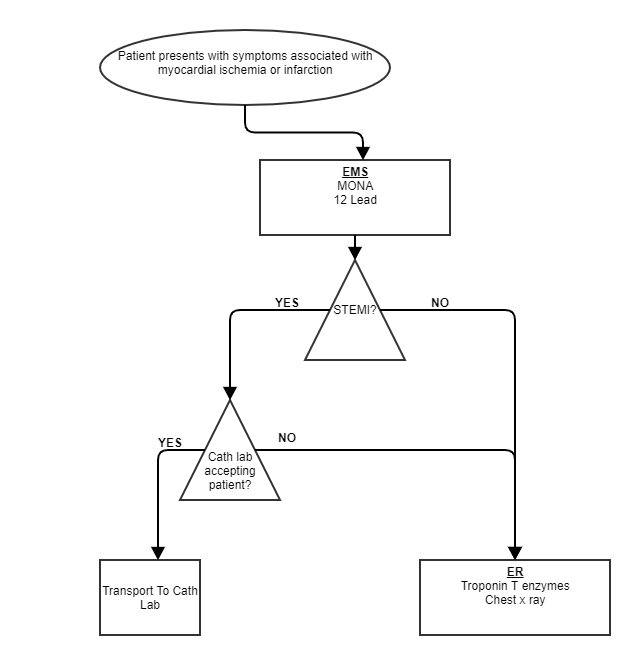Management of Cardiovascular Emergencies
Published .

Truth Be Told, The Dispatcher, EMS, and the ER Couldn’t Find A Heart Attack In A Basket Of Puppies
Most cases of Acute Coronary Syndrome are dispatched to EMS as a chest pain call. Ambulance services will send an Advanced Life Support ambulance to the scene. The Advanced Life Support Ambulance has the capability of treating the heart attack with nitro, morphine, and aspirin as well as performing a 12 lead EKG. The efforts of the Paramedics are rewarded with the option of transporting directly to a Cath lab if a 12 lead reveals some telltale signs. A Cath lab is capable of emergency angioplasty which can restore blood flow to an obstructed coronary artery. Obviously, not all patients will be transported to the Cath lab. Most will be transported to the Emergency Department, where they will be monitored for 24 hours. The following are non-cardiac causes of chest pain:
- indigestion or reflux (heartburn) — when stomach acid rises up the food pipe, and causes a burning pain in the chest –
- muscle strains
- inflammation where the ribs join the breast bone (known as costochondritis)
- chest infections such as bronchitis and pneumonia
- pleurisy (inflammation of the tissue lining the lungs)
- anxiety or panic attack — these may also cause dizziness, heart palpitations, sweating and breathlessness and can last for up to 20 minutes.
It is estimated that less than 10% of all patients complaining of chest pain are actually having a problem with their heart. Despite such odds, EMS treats all patients with chest pain as they are having a heart attack.
The Plan For Chest Pain

When the ambulance crew arrives to a patient with chest pain, they are confronted with a patient who is potentially experiencing acute coronary syndrome (heart attack). The primary survey will likely be unremarkable, at most requiring oxygen to the patient complaining of shortness of breath. The AHA no longer recommends routine administration of oxygen unless the patient is experiencing shortness of breath. The treatment from EMS is fairly straightforward. After assessing the patient with a focused history and physical exam (SAMPLE history, vital signs, and EKG), the medics administer 324 mg Aspirin then 0.4 mg Nitroglycerin sublingual every 5 minutes (assuming the blood pressure remains reasonably normal). The medics may administer Morphine. The medics will assess the patient’s 12 lead EKG to determine if there are any signs of ischemia (decreased blood flow through coronary arteries). If the patient presents with ischemia on the 12 lead, the medics will coordinate further care with a Cath lab. If the Cath lab accepts the patient, the medics will bypass the Emergency Department. The idea is transport the patient to the correct location in lieu of any delays at the Emergency Department. The triage strategy is below:

Patients with signs of ischemia will be transported to the Cath lab for aggressive treatment. The other patients will more than likely be observed for a period of time, some of which may be treated at the Cath lab.
Anybody Could Experience Acute Coronary Syndrome, Even If They Have An Unrelated Complaint
Pediatric patients generally have no problems with their heart or circulatory system, but could develop cardiac problems due to hypoxia. Further, some pediatric patients have congenital heart defects that may require treatment by a cardiologist.
The side effects of long term medications used to treat asthma or COPD often effect the cardiovascular system. To make matters worse, patients with exacerbations of COPD or asthma often complain of chest pain. Diabetics can lose feeling in various parts of their body due to damage to the nervous system from diabetic neuropathy. Diabetics have the highest risk of developing coronary artery disease. Combine not being able to feel the chest pain with the highest risk factors and you get a ‘Silent MI’ (heart attack with no chest pain). Women are also at a higher risk for developing a silent or at atypical presentation of heart attack.
